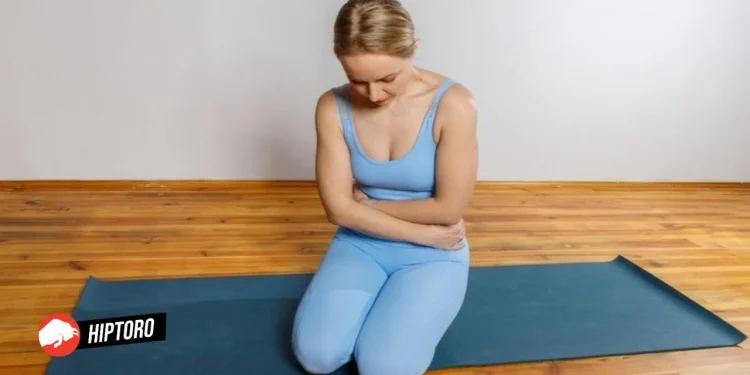Embarking on a journey through yoga reveals a vast array of poses designed to harmonize the body, mind, and spirit. Among these, certain asanas stand out for their specific benefits in alleviating menstrual discomfort—a common ailment that affects many.
Period cramps, or dysmenorrhea, can range from mild to debilitating, impacting daily activities and overall well-being. However, the ancient practice of yoga offers a gentle, effective approach to managing these symptoms, promoting relief and comfort during menstruation.
Yoga, with its emphasis on mindful movement, breath control, and meditation, provides a holistic remedy to the physical pain and emotional turbulence associated with period cramps. The practice encompasses various poses that target the pelvic area, improving circulation, easing muscle tension, and fostering a sense of relaxation.
From gentle forward folds and soothing twists to restorative backbends, yoga poses can be strategically utilized to address and alleviate menstrual discomfort.
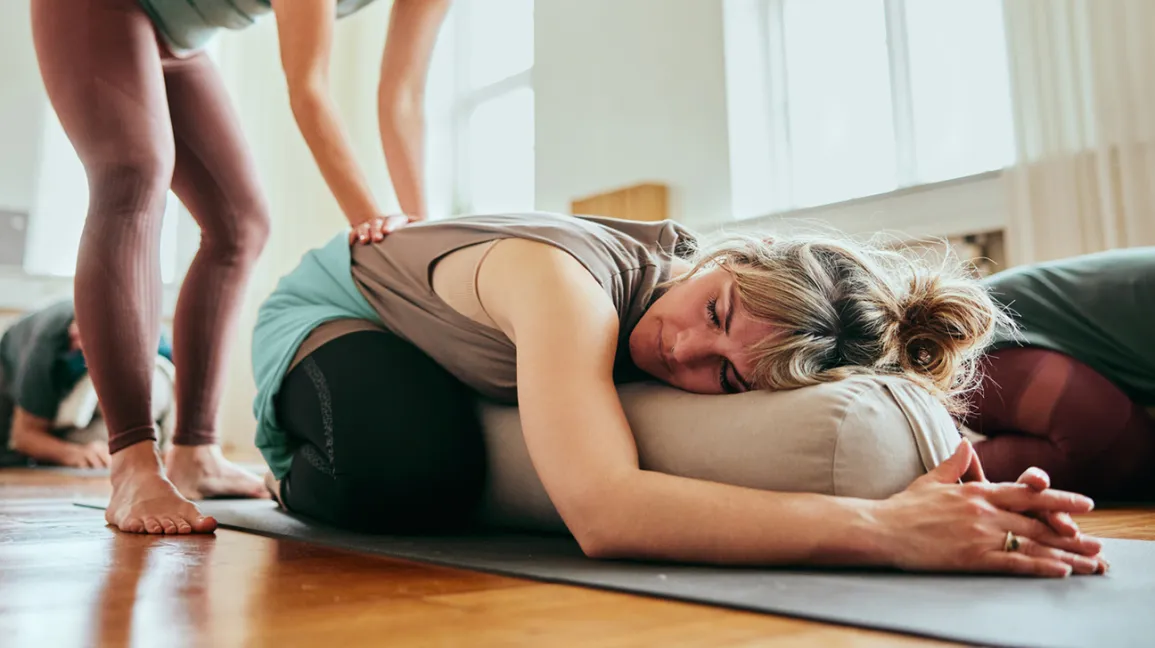
This exploration into the top yoga poses for period cramps will not only highlight the specific asanas that offer relief but also delve into the underlying principles of yoga that support menstrual health.
By integrating these poses into a regular practice, individuals can harness the therapeutic power of yoga, navigating the challenges of menstruation with greater ease and resilience. The journey through these carefully selected asanas promises a path to enhanced well-being, empowering practitioners to embrace their menstrual cycle with a sense of peace, strength, and balance.
Top Yoga Poses for Period Cramps
After extensive research and consideration of various yoga poses known for their effectiveness in easing menstrual discomfort, the following poses have been identified as particularly beneficial:
- Child’s Pose (Balasana)
- Cat-Cow Stretch (Marjaryasana-Bitilasana)
- Forward Fold (Uttanasana)
- Supine Twist (Supta Matsyendrasana)
- Camel Pose (Ustrasana)
- Cobra Pose (Bhujangasana)
- Butterfly Pose (Baddha Konasana)
- Fish Pose (Matsyasana)
- Pigeon Pose (Eka Pada Rajakapotasana)
- Savasana (Corpse Pose)
These poses have been selected for their ability to reduce tension, promote relaxation, and enhance blood flow in the pelvic region, which can significantly alleviate cramps and discomfort during menstruation.
1. Child’s Pose (Balasana) – A Refuge of Comfort
In the vast and varied practice of yoga, certain poses stand out for their simplicity, accessibility, and profound healing effects. Among these, Child’s Pose, or Balasana, serves as a sanctuary of solace and comfort, particularly renowned for its ability to alleviate physical discomfort and emotional stress. This pose, emblematic of rest and renewal, holds a special place in the realm of yoga for menstrual health, offering a gentle yet powerful remedy for the discomfort associated with menstrual cramps.
The Essence of Balasana
Child’s Pose mimics the natural fetal position, embodying a posture of humility and surrender. By folding the body forward and allowing the forehead to rest upon the earth, it creates a profound sense of security and comfort. This pose is not merely a physical gesture; it’s a return to the origins, a symbolic embrace of peace and self-compassion that resonates deeply within the human psyche.
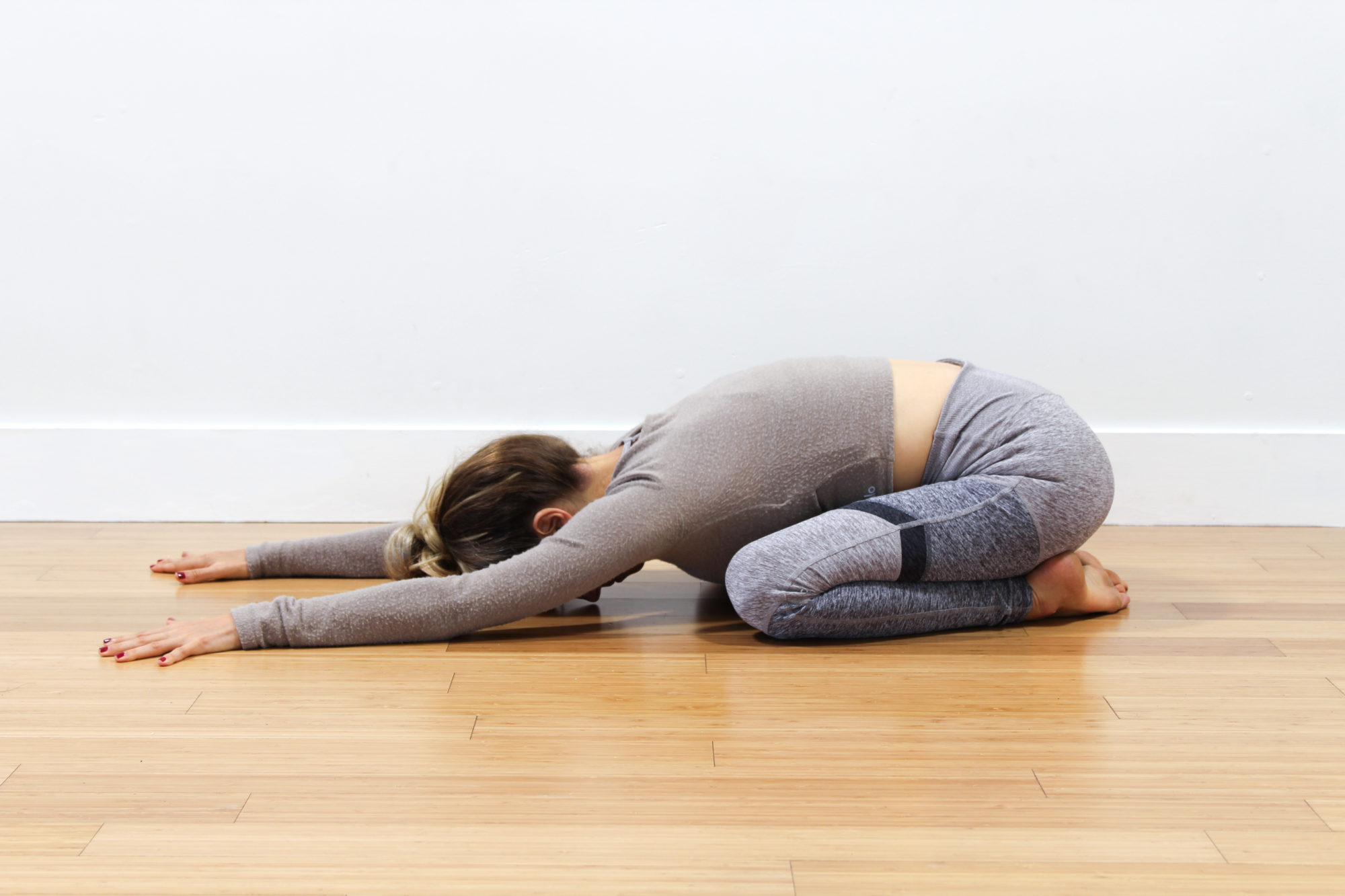
Physical Benefits: A Balm for Menstrual Cramps
The physical configuration of Balasana works wonders on the body, especially during menstruation. As the torso folds over the thighs, the pose gently compresses the abdominal muscles, providing a soothing massage to the organs within the pelvic and belly area.
This action can help relieve the tension and spasms associated with menstrual cramps, offering a natural form of pain relief. Furthermore, the stretch in the lower back and hips helps to release accumulated stress and stiffness in these areas, which is often exacerbated during the menstrual cycle.
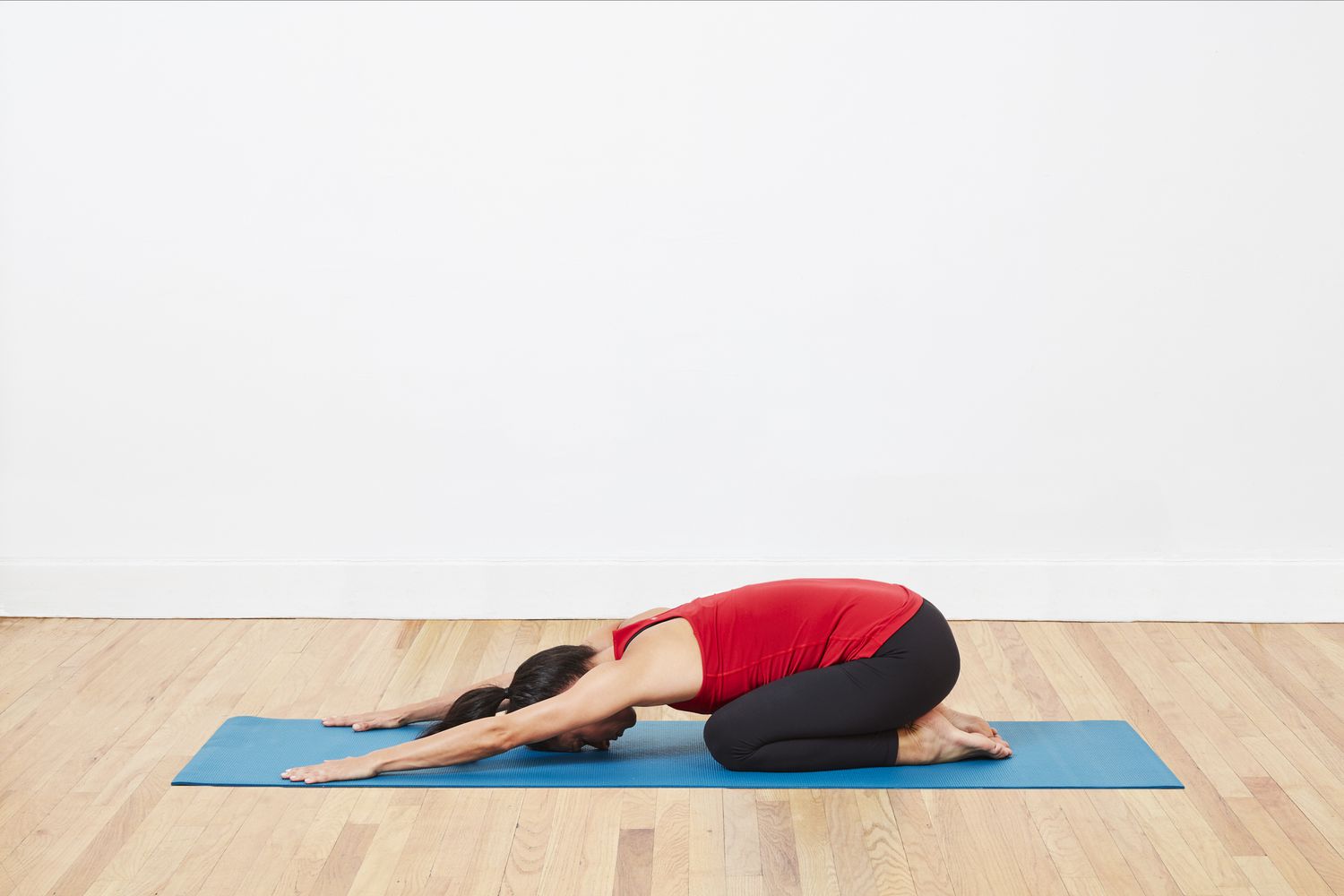
Emotional and Mental Relief
Beyond its physical benefits, Child’s Pose is a haven for emotional and mental well-being. In the safety of this pose, the mind is encouraged to let go of external worries and stressors, turning inward to find peace and stillness. The act of resting the forehead on the ground activates the body’s relaxation response, reducing anxiety and calming the nervous system. This pose serves as a gentle reminder that taking time for rest and introspection is not only acceptable but necessary for holistic health.
Practicing Balasana
To reap the full benefits of Child’s Pose, approach it with intention and mindfulness:
- Start on your knees, sitting back on your heels with your knees either together for a more intense stretch in the thighs and groin or spread apart to create space for the torso.
- Fold forward, extending your arms out in front of you or alongside your body, allowing your forehead to gently touch the ground.
- Breathe deeply, focusing on the expansion and contraction of the back with each breath, inviting relaxation and release with every exhale.
- Hold the pose for anywhere from 30 seconds to a few minutes, depending on your comfort and needs.

Modifications and Considerations
While Balasana is generally safe for most individuals, it’s important to listen to your body and make necessary adjustments. For extra support, a bolster or pillow can be placed under the torso or forehead. Those with knee issues may want to place a folded blanket under the knees or ankles for added cushioning.
2. Cat-Cow Stretch (Marjaryasana-Bitilasana): A Dynamic Duo for Well-being
In the realm of yoga, certain sequences stand out for their simplicity and profound impact on the practitioner’s physical and mental state. The Cat-Cow Stretch, comprising Marjaryasana (Cat Pose) and Bitilasana (Cow Pose), is one such sequence that harmonizes the body and mind through gentle, flowing movements. This dynamic duo is particularly beneficial in alleviating menstrual cramps, improving posture, and enhancing mental clarity.
The Synergy of Marjaryasana and Bitilasana
The Cat-Cow Stretch is a fluid movement between two poses that warms up the spine and relieves tension in the torso and neck. By alternating between arching the back (Cat Pose) and lifting the head and tailbone towards the sky (Cow Pose), this sequence fosters spinal flexibility and abdominal strength. For those experiencing menstrual discomfort, the gentle stretching and contracting of the abdomen can provide significant relief from cramps and stiffness.
Physical Benefits: Beyond Menstrual Relief
The Cat-Cow Stretch offers a myriad of physical benefits. It increases spinal flexibility and mobility, which is crucial for maintaining a healthy posture and preventing back pain. The alternating movements also massage the abdominal organs, stimulating the digestive system and enhancing circulation in the pelvic area. This increased blood flow can help in easing menstrual cramps and promote overall reproductive health.
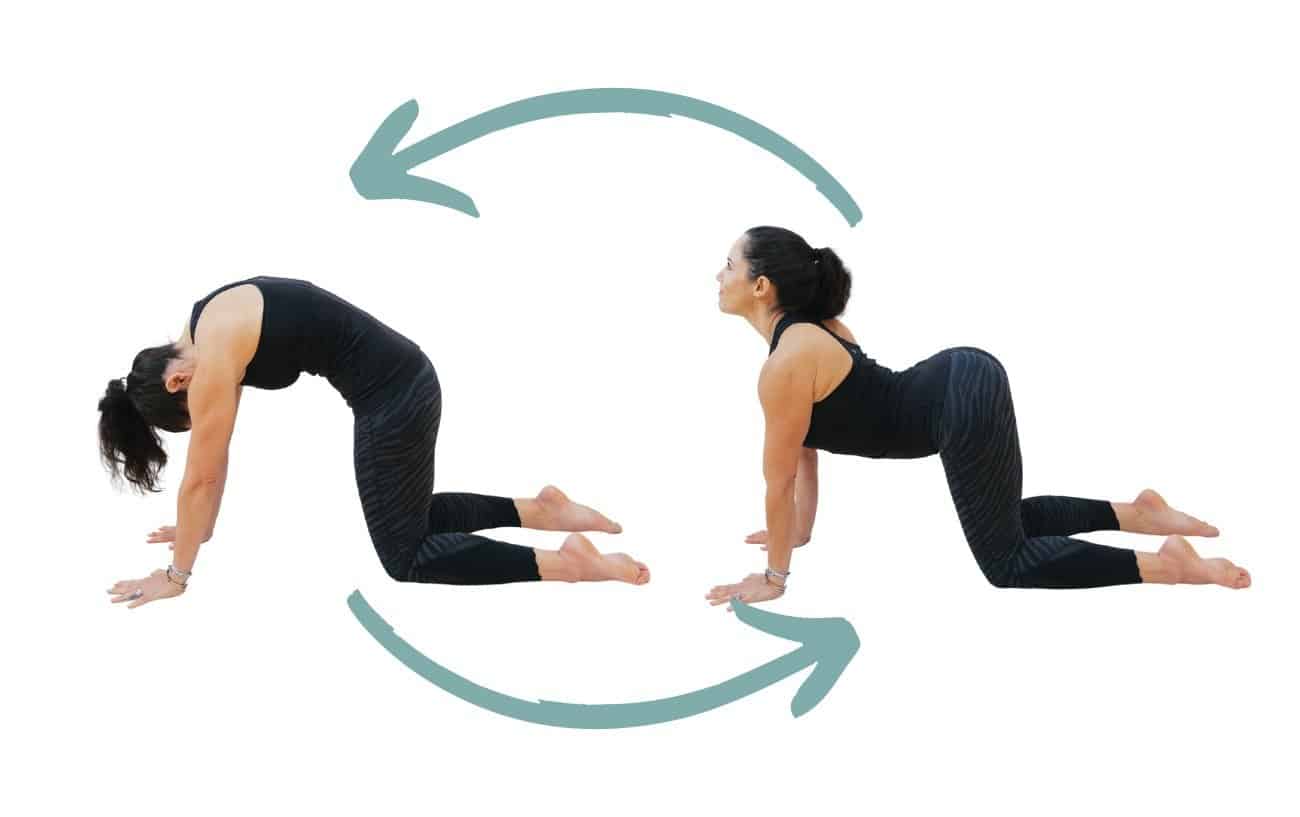
Moreover, the activation of the abdominal muscles during the sequence strengthens the core, providing stability and support for the entire body. This core engagement is essential not only for physical balance but also for protecting the lower back from strain during daily activities.
Mental and Emotional Harmony
Beyond its physical advantages, the Cat-Cow Stretch plays a significant role in calming the mind and easing stress. The coordinated movement with breath work—a fundamental aspect of the sequence—enhances focus and mental clarity. Each inhalation during Cow Pose and exhalation during Cat Pose encourages mindfulness and a meditative state, reducing anxiety and promoting a sense of inner peace.
For individuals navigating the emotional turbulence often associated with the menstrual cycle, this sequence can serve as a grounding exercise, helping to balance mood swings and alleviate mental fatigue.
Practicing Marjaryasana-Bitilasana
To fully benefit from the Cat-Cow Stretch, follow these steps with attention to form and breath:

- Begin on all fours, with your wrists aligned under your shoulders and your knees under your hips. Keep your spine neutral and your gaze softly directed downwards.
- Inhale, Cow Pose: Arch your back by lowering your belly towards the mat, lifting your head and tailbone upwards. Focus on opening your chest and drawing your shoulders away from your ears.
- Exhale, Cat Pose: Round your spine upwards, tucking your tailbone under and bringing your chin towards your chest. Press through your hands to deepen the stretch along your back.
Flow seamlessly between these poses for 1-3 minutes, allowing your breath to guide the movement.
Modifications and Cautions
While the Cat-Cow Stretch is suitable for most, those with severe back issues or neck pain should proceed with caution. Incorporating modifications, such as placing a folded blanket under the knees or performing the sequence with a more gentle range of motion, can make it accessible and comfortable for everyone.
3. Forward Fold (Uttanasana): A Journey Towards Inner Calm and Physical Release
In the expansive practice of yoga, the Forward Fold, or Uttanasana, stands out as a fundamental pose that marries the simplicity of form with profound benefits for the body and mind. This seemingly straightforward posture, involving a deep bend at the hips to fold the upper body over the legs, is a cornerstone in yoga for its versatility and the extensive range of benefits it offers. Particularly during the menstrual cycle, Uttanasana can serve as a soothing balm for cramps, offering not only physical relief but also a moment of introspection and peace.
The Essence of Uttanasana
Uttanasana is more than just a physical stretch; it’s an invitation to turn inward, to quiet the mind, and to release tension that we often carry unknowingly. By folding forward, the body naturally encourages the release of the back muscles and the extension of the hamstrings and calves, which can be particularly tight due to prolonged sitting or standing in our daily lives. This pose also stimulates the abdominal organs, including those involved in the menstrual cycle, providing a gentle massage that can help alleviate cramps and improve digestive health.
Alleviating Menstrual Discomfort
For those who experience discomfort during their menstrual cycle, Uttanasana offers a natural method for easing cramps. The forward bend facilitates gentle pressure on the lower abdomen, similar to a soothing hug, which can help to relax the muscles and reduce the intensity of cramps. This pose also enhances circulation in the pelvic region, promoting healing and reducing the feeling of bloating and heaviness that often accompanies menstruation.
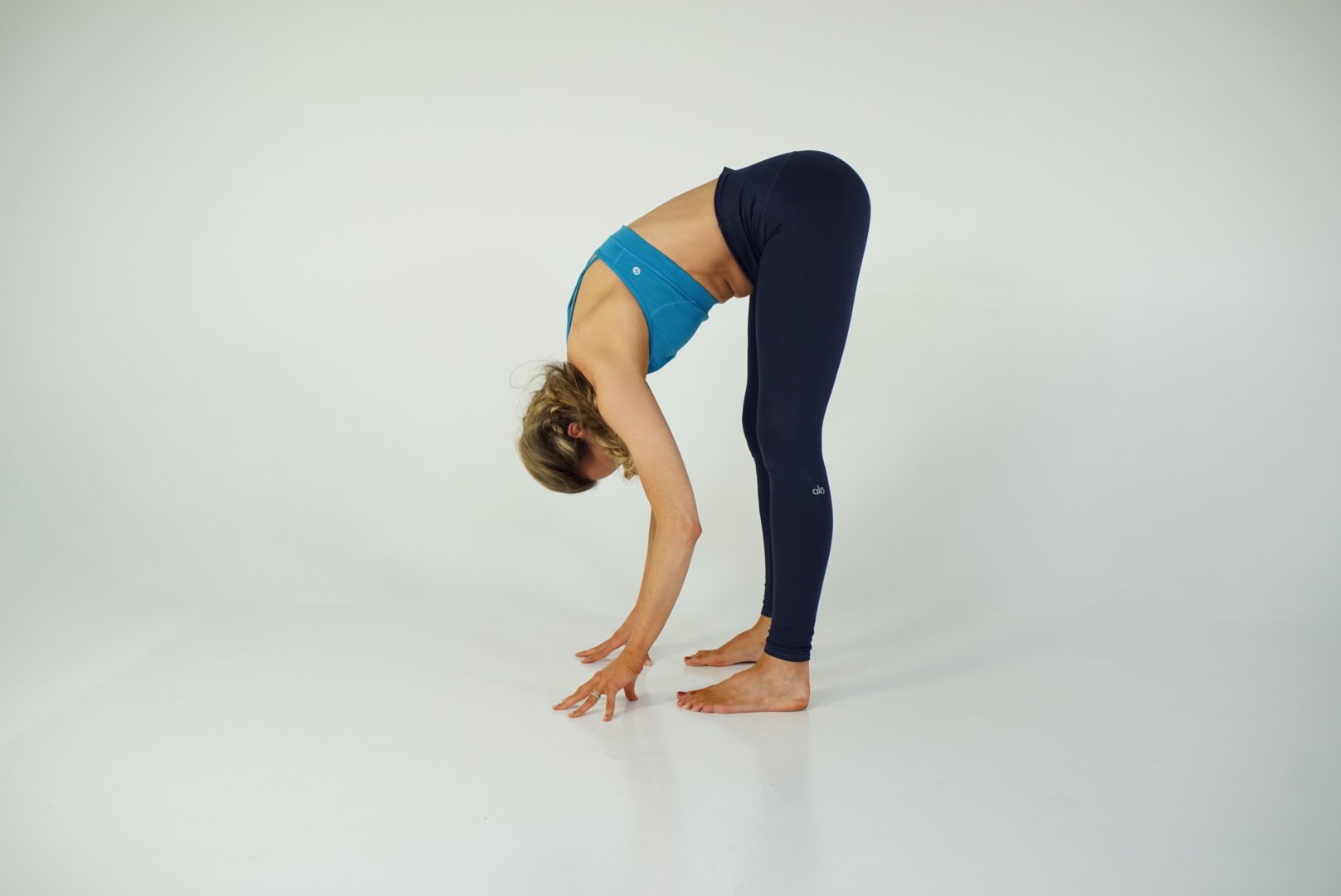
Beyond Physical Relief: Mental and Emotional Benefits
The Forward Fold is not just about physical relief; it’s also a powerful tool for mental and emotional well-being. The act of bending forward and letting the head hang freely encourages a release of stress and anxiety, as it symbolically allows worries to pour out of the crown of the head. This pose fosters a sense of surrender and release, offering a break from the constant stimulation of the external world and inviting practitioners to find a moment of quietude and introspection.
Practicing Uttanasana
To gain the maximum benefits from Uttanasana, it’s essential to approach the pose with mindfulness and respect for one’s body:
1. **Start in a standing position**, with feet hip-width apart for stability. Inhale deeply to lengthen the spine.
2. **Exhale and hinge at the hips**, folding forward. Bend the knees slightly if you have tight hamstrings or are experiencing back discomfort.
3. **Let your hands rest** on the ground, your shins, or hold onto your elbows to deepen the stretch gently.
4. **Relax your head and neck**, allowing gravity to help extend the spine. With each breath, seek to release tension held in the body.
5. **Hold the pose** for 30 seconds to a minute, breathing deeply to encourage relaxation and release.

Modifications for Menstrual Health
For those practicing Uttanasana during their menstrual cycle, incorporating modifications can enhance comfort and effectiveness. Using props like yoga blocks to support the hands if they don’t reach the floor or practicing a half-lift variation to reduce pressure on the abdomen can make the pose more accessible and beneficial.
4. Supine Twist (Supta Matsyendrasana): Unraveling Tension, Enhancing Well-being
In the landscape of yoga practices, the Supine Twist, or Supta Matsyendrasana, emerges as a profoundly therapeutic pose, weaving together the threads of physical ease, emotional balance, and holistic health. This gentle yet powerful twist offers a unique combination of spinal decompression, organ massage, and stress relief, making it an essential element of any yoga routine, especially for those seeking solace from menstrual discomfort.
The Healing Essence of Supta Matsyendrasana
Supta Matsyendrasana, performed while lying on the back with the legs and hips gently twisted to one side, is a beacon of restoration. It serves not just as a physical posture but as a meditative practice, guiding practitioners toward inner tranquility and physical release. This pose stands out for its ability to address the spine’s health, promote digestive and reproductive organ function, and offer a profound sense of relaxation and release.
A Balm for Menstrual Cramps
For individuals navigating the ebbs and flows of the menstrual cycle, the Supine Twist acts as a natural remedy for cramps and tension. By gently twisting the abdomen, this pose facilitates a subtle massage for the internal organs, including the uterus, which can help to alleviate cramping and improve blood flow. The relaxation induced by the twist also helps to diminish the overall sensation of discomfort, offering a holistic approach to menstrual well-being.
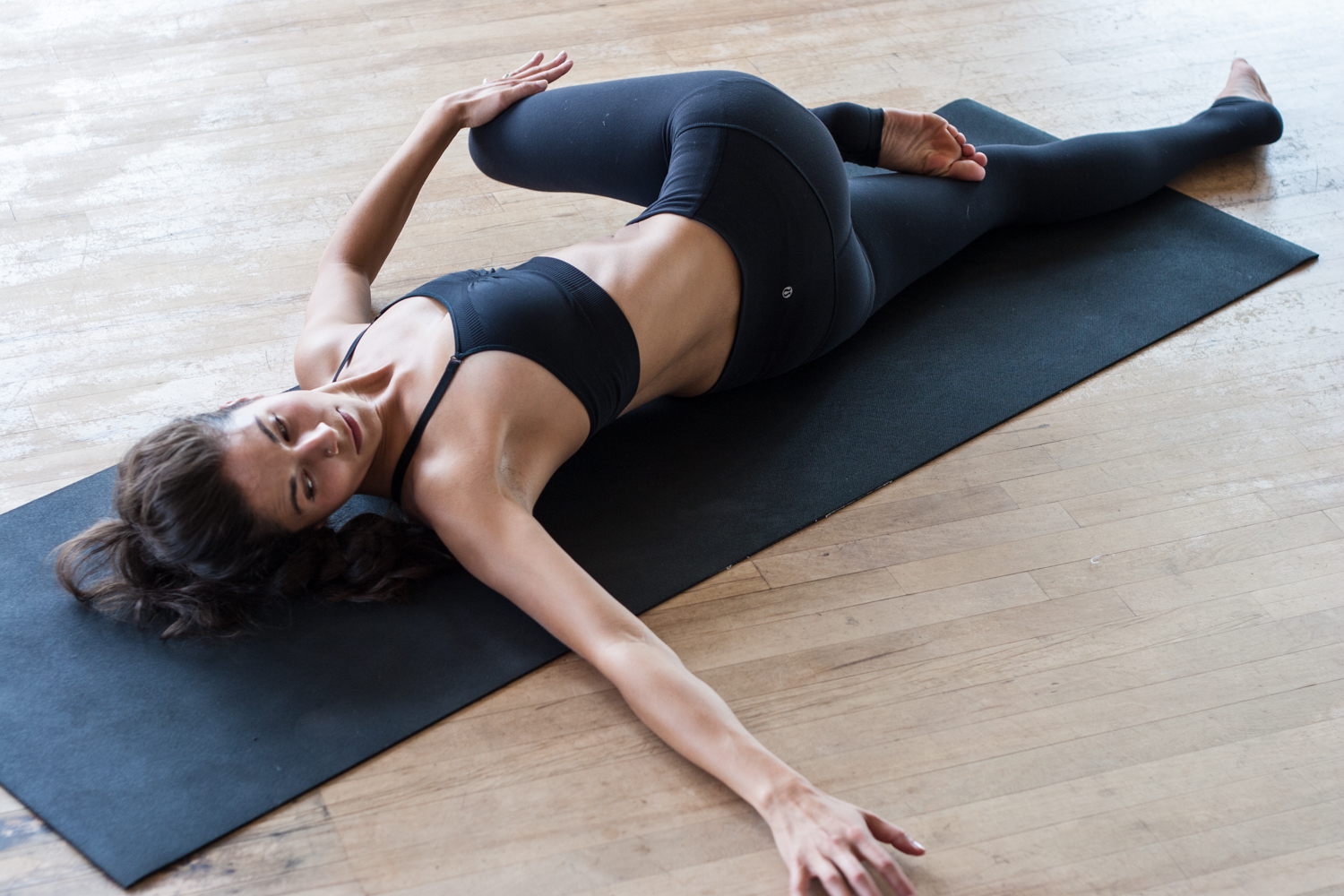
Beyond Physical Relief: A Journey to Emotional Equilibrium
The benefits of Supta Matsyendrasana extend beyond the physical realm, touching the depths of emotional well-being. In the cocoon of the twist, practitioners often experience a release of emotional tension and stress as the pose encourages letting go of what no longer serves. This symbolic and physical unwinding can lead to improved mental clarity, reduced anxiety, and a heightened sense of peace.
Practicing Supta Matsyendrasana
Embracing the full potential of the Supine Twist requires mindful engagement with the pose:
- Begin by lying on your back with your arms extended in a T-shape for support.
- Bend your knees, bringing them towards your chest, then gently lower them to one side, keeping your shoulders anchored to the ground.
- Turn your head gently in the opposite direction of your knees, encouraging a full spinal twist.
- Breathe deeply, allowing each exhale to deepen the twist, and each inhale to create space within.
- Hold the pose for 1-3 minutes on each side, observing the sensations that arise and embracing the release with each breath.

Tailoring the Twist for Menstrual Health
When practicing Supta Matsyendrasana during menstruation, it’s crucial to listen to the body’s cues and adjust accordingly. Using a cushion or folded blanket under the knees can provide additional support and comfort, making the twist more accessible and enjoyable.
5. Camel Pose (Ustrasana): Embracing Openness and Strength
In the dynamic practice of yoga, Camel Pose, or Ustrasana, stands as a beacon of vitality, flexibility, and emotional release. This heart-opening backbend challenges and nurtures, offering profound benefits that echo through the practitioner’s physical and emotional landscapes. Especially for those seeking relief from menstrual discomfort, Ustrasana offers a unique combination of abdominal stretching, pelvic opening, and stress alleviation, making it a valuable asset in the holistic management of menstrual health.
The Vitality of Ustrasana
Ustrasana is not merely a physical posture; it’s an embodiment of openness and resilience. By exposing the heart and stretching the front body, Camel Pose invites practitioners to confront vulnerability and embrace strength. This pose uniquely stimulates the abdominal organs and improves spinal flexibility, providing a boost in energy and facilitating a deeper connection with one’s inner self.
Alleviating Menstrual Discomfort
For individuals experiencing the physical and emotional upheavals of the menstrual cycle, Camel Pose can serve as a soothing balm. The extension of the abdomen and the gentle pressure on the pelvic region can help to alleviate cramping and tension, promoting better circulation and easing discomfort. Moreover, the heart-opening nature of Ustrasana is particularly beneficial in releasing emotional stress and fostering a sense of well-being during this sensitive time.
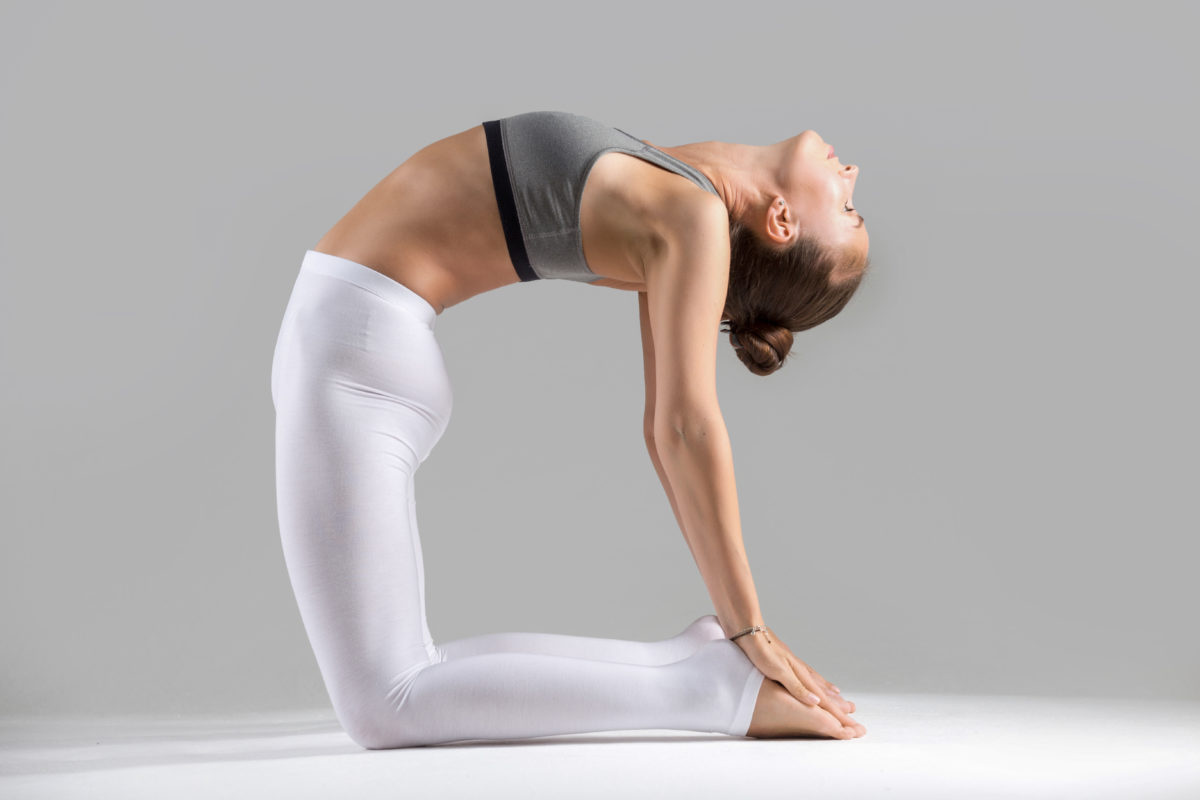
Beyond Physical Relief: A Portal to Emotional Liberation
Ustrasana transcends physical benefits, touching the core of emotional and spiritual well-being. As a heart-opening pose, it challenges practitioners to let go of fear and embrace vulnerability, which can be particularly empowering during menstruation, a period often marked by heightened emotions and sensitivity. The courage to open up in Camel Pose mirrors the strength required to navigate the complexities of life, offering lessons in resilience and self-compassion.
Practicing Ustrasana
To harness the full potential of Camel Pose, it’s essential to approach the practice with mindfulness and care:
1. **Begin by kneeling** on your yoga mat, with your knees hip-width apart and your hands on your lower back for support.
2. **Inhale and lengthen** your spine, gently arching back, leading with your chest towards the ceiling, and keeping your hips over your knees.
3. **Reach back** to place your hands on your heels or ankles, depending on your flexibility, while maintaining the lift and openness in your chest.
4. **Keep your neck** in a neutral position or allow it to drop back gently, ensuring there’s no strain.
5. **Hold the pose** for a few breaths, experiencing the stretch in your front body and the openness in your chest.
6. **To exit**, bring your hands back to your lower back for support, and slowly come up, leading with your heart to avoid strain on your back.

Mindful Modifications for Menstrual Health
While Ustrasana offers significant benefits, listening to one’s body is crucial, especially during menstruation. For those new to the pose or experiencing discomfort, practicing a modified version with hands on the lower back or using props like blocks beside each foot can provide stability and ease in the pose.
6. Cobra Pose (Bhujangasana): A Serpentine Path to Healing and Empowerment
Cobra Pose, or Bhujangasana, is a quintessential backbend that embodies the grace and strength of a serpent rising. This pose is a cornerstone in yoga practice for its simplicity and profound impact on the practitioner’s physical and emotional well-being. Particularly beneficial for those experiencing menstrual discomfort, Bhujangasana offers a unique blend of spinal extension, abdominal strengthening, and emotional release, making it a powerful tool in the holistic management of menstrual health.
Unveiling the Essence of Bhujangasana
Bhujangasana is more than a physical stretch; it’s a symbolic gesture of shedding old layers and embracing renewal and growth. By engaging the back muscles to lift the chest off the ground, Cobra Pose stimulates the abdominal organs, improves spinal flexibility, and opens the heart and lungs. This gentle yet effective backbend is accessible to practitioners of all levels, offering a pathway to improved posture, alleviated back pain, and enhanced lung capacity.
Soothing Menstrual Discomfort
For individuals navigating the ebbs and flows of the menstrual cycle, Bhujangasana can serve as a gentle remedy for cramps and tension. The pose’s ability to stretch the front body while strengthening the back helps to relieve stiffness and discomfort in the abdominal and lower back areas. Additionally, the mild compression in the lower abdomen during the pose can stimulate the reproductive organs, promoting circulation and easing menstrual cramps.
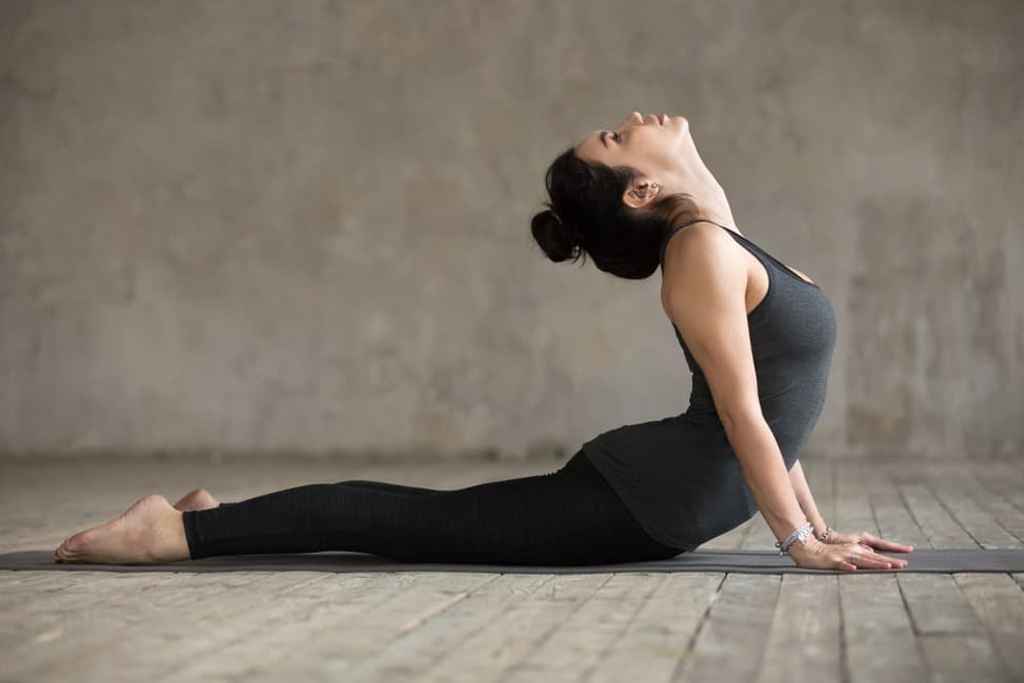
Beyond Physical Benefits: Fostering Emotional Resilience
Cobra Pose transcends its physical benefits, touching the realms of emotional healing and resilience. As a heart-opening posture, Bhujangasana encourages practitioners to face vulnerabilities with courage and openness. This emotional release is particularly relevant during menstruation, a time that may bring heightened sensitivity and introspection. Engaging in Bhujangasana offers an opportunity to release emotional baggage, foster self-compassion, and cultivate inner strength.
Practicing Bhujangasana
To fully embrace the benefits of Cobra Pose, consider the following steps with mindfulness and respect for your body’s limitations:
1. **Start by lying prone** on your yoga mat, with your legs extended behind you and your palms placed under your shoulders.
2. **Inhale and gently lift** your chest off the floor, using the strength of your back muscles rather than pushing with your hands. Keep your elbows close to your body to engage the correct muscles.
3. **Hold your gaze forward** or slightly upwards, ensuring your neck remains an extension of your spine, avoiding strain.
4. **Maintain the pose** for 15 to 30 seconds, focusing on the sensation of opening across your chest and the gentle stretch in your abdominal muscles.
5. **To exit,** slowly lower your chest back to the ground on an exhale, releasing the pose with care and mindfulness.

Tailoring Bhujangasana for Menstrual Health
While Bhujangasana is generally beneficial during menstruation, it’s important to listen to your body and adjust the pose as needed. Practicing a milder version of the pose, with less extension in the back, can provide benefits without causing discomfort. Utilizing props, such as a folded blanket under the hips, can also enhance comfort and support during the practice.
7. Butterfly Pose (Baddha Konasana): A Gentle Embrace for Holistic Well-being
In the rich tapestry of yoga, Butterfly Pose, or Baddha Konasana, occupies a special place with its gentle, grounding energy and profound health benefits. This seated pose, characterized by the soles of the feet touching with knees wide apart, mimics the serene stance of a butterfly at rest, offering a moment of calm and introspection. Particularly during menstruation, Baddha Konasana provides a soothing stretch that can alleviate discomfort, promote pelvic health, and foster emotional balance.
The Essence of Baddha Konasana
Butterfly Pose transcends mere physical stretching; it is a meditative posture that invites practitioners to slow down and connect with their inner selves. By facilitating a deep opening in the hips and groin area, Baddha Konasana enhances flexibility, stimulates the abdominal organs, and supports the health of the reproductive system. This pose is accessible to yogis of all levels, serving as a nurturing practice that encourages self-care and mindfulness.
Alleviating Menstrual Discomfort
For those experiencing the physical and emotional challenges of the menstrual cycle, Butterfly Pose can offer significant relief. The gentle hip opening helps to release tension in the pelvic floor and alleviate cramping, while the forward fold variation can soothe lower back pain and enhance relaxation. Moreover, the stimulation of the abdominal organs promotes healthy digestion and circulation, reducing the bloating and discomfort often associated with menstruation.
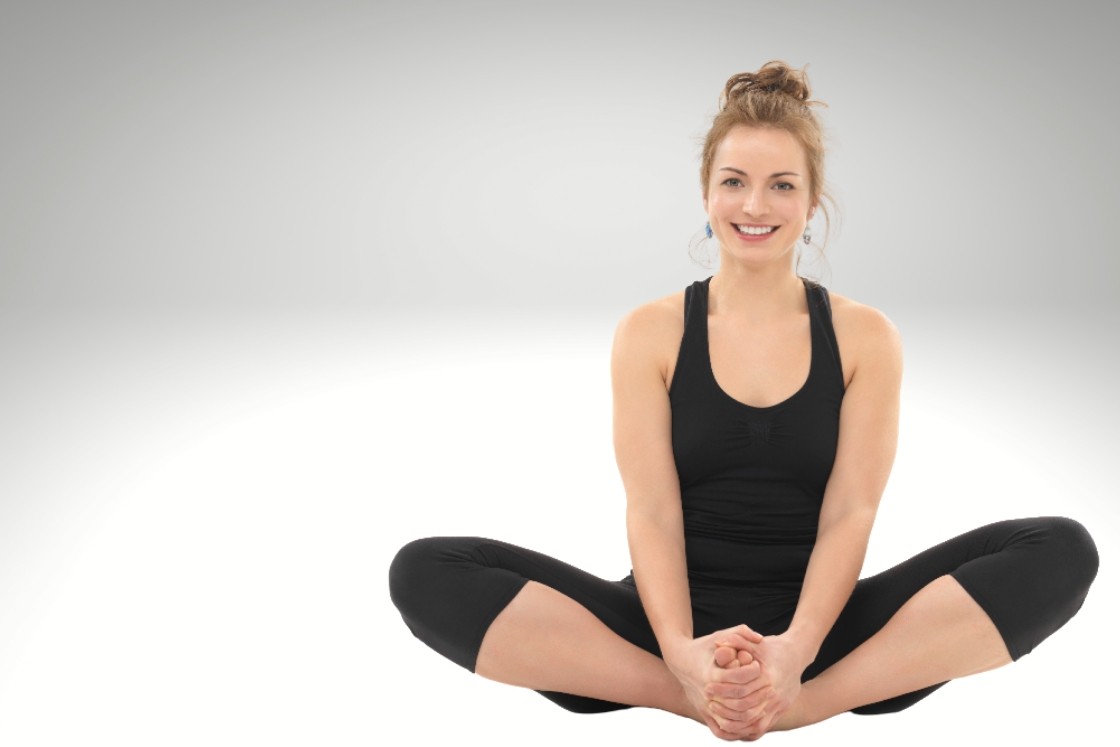
Beyond Physical Benefits: Cultivating Emotional Equilibrium
Baddha Konasana is not only beneficial for physical health but also for emotional and mental well-being. The pose’s grounding effect helps to calm the mind, reduce stress, and alleviate anxiety, making it particularly valuable during the heightened emotional sensitivity of menstruation. Practicing Butterfly Pose invites a moment of introspection and self-compassion, allowing individuals to nurture their emotional selves and embrace a sense of inner peace.
Practicing Baddha Konasana
To reap the full benefits of Butterfly Pose, approach the practice with intention and gentle awareness:
1. **Begin seated** with your spine straight and legs extended in front of you. Bring the soles of your feet together, drawing them as close to your body as comfortable, allowing your knees to fall open to the sides.
2. **Inhale deeply**, lengthening your spine and engaging your core slightly to support your back.
3. **Exhale and gently fold forward**, keeping the spine long. Use your elbows to press the knees down lightly for a deeper hip opening, if comfortable.
4. **Hold the pose** for 1-3 minutes, focusing on deep, steady breaths. Allow each exhale to deepen the stretch gently without forcing the body.
5. **To exit**, inhale and slowly rise, using your hands to support your knees as you bring them together.

Tailoring Baddha Konasana for Menstrual Health
Practicing Baddha Konasana during menstruation should be approached with care, listening to the body’s cues. Using props, such as cushions under the knees or sitting on a folded blanket for added hip elevation, can enhance comfort and support. Adjusting the intensity of the forward fold according to one’s comfort level can also ensure the practice remains nurturing and beneficial.
8. Fish Pose (Matsyasana): Navigating the Waters of Health and Harmony
In the vast ocean of yoga asanas, Fish Pose, or Matsyasana, emerges as a beacon of flexibility, strength, and tranquility. This graceful backbend, characterized by its heart-opening and throat-stretching attributes, offers a counterbalance to the forward-bending motions that dominate daily life. Particularly beneficial during menstruation, Matsyasana serves as a gentle yet potent posture for alleviating discomfort, enhancing respiratory health, and fostering emotional release, making it a valuable addition to a holistic menstrual health regimen.
The Essence of Matsyasana
Matsyasana transcends its aesthetic grace, delving deep into the realms of therapeutic benefits. Opening the chest and stretching the throat promotes better lung capacity and stimulates the thyroid gland, balancing hormone levels. The gentle pressure on the abdomen massages internal organs, aiding in digestion and menstrual discomfort relief. Fish Pose also counters the effects of prolonged sitting or standing, combating postural imbalances and nurturing spinal health.
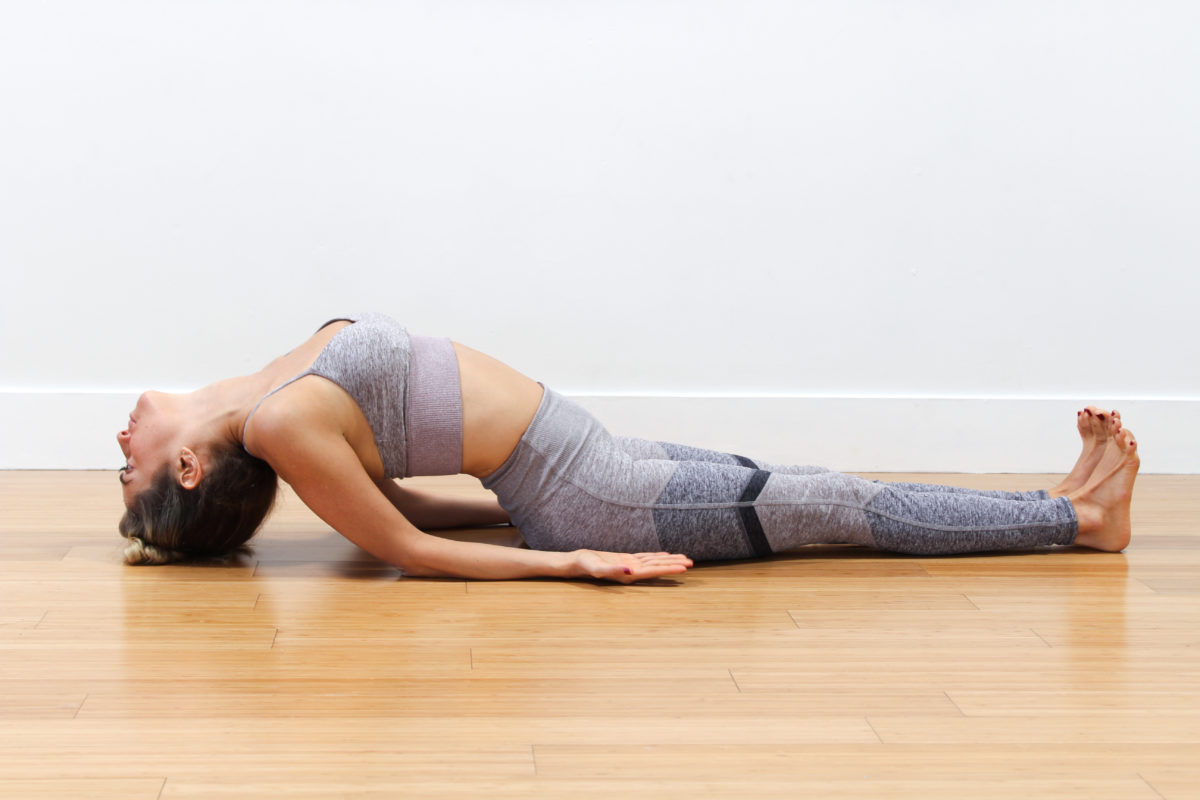
Alleviating Menstrual Discomfort
For those grappling with the cramps, bloating, and lethargy associated with the menstrual cycle, Matsyasana can be a source of relief and rejuvenation. The pose’s emphasis on opening the front body helps to relieve tension in the abdominal area, easing cramps and facilitating a smoother flow. Additionally, the activation of the throat and chest areas in this pose can help alleviate the emotional swings and stress that often accompany menstruation, promoting a sense of calm and balance.
Beyond Physical Relief: A Portal to Emotional Equilibrium
Matsyasana is not merely a physical posture; it’s an emotional and spiritual journey. The act of opening the heart and exposing the throat in this pose encourages vulnerability and emotional release, offering a pathway to confront and release pent-up feelings. This heart-opening aspect of Fish Pose is especially poignant during menstruation, a time when many experience heightened sensitivity and introspection. Practicing Matsyasana invites a dialogue with one’s inner self, fostering emotional resilience and self-acceptance.
Practicing Matsyasana
To fully embrace the benefits of Fish Pose, it’s essential to approach the practice with mindfulness and care:
1. **Begin by lying flat** on your back, legs extended, and arms resting by your sides.
2. **Place your hands** under your hips, palms facing down, and elbow close to your sides.
3. **Inhale and press** into your elbows and palms, lifting your chest towards the ceiling. Gently tilt your head backward, resting the crown or the back of your head on the floor, depending on your neck’s comfort.
4. **Maintain the pose** for 15 to 30 seconds, focusing on deep breaths that expand the chest and abdomen.
5. **To exit,** gently lift your head, releasing your chest and lowering your body back to the floor.

Tailoring Matsyasana for Menstrual Health
While Matsyasana offers significant benefits, it’s crucial to listen to your body and make necessary adjustments, especially during menstruation. Practicing a milder version of the pose, without arching too deeply, can provide the benefits without causing discomfort. Using props, such as a cushion or yoga block under the back, can also enhance the pose’s comfort and accessibility.
9. Pigeon Pose (Eka Pada Rajakapotasana): A Journey to Flexibility and Inner Peace
In the rich tapestry of yoga, Pigeon Pose, or Eka Pada Rajakapotasana, stands as a profound testament to the balance between strength and surrender. This deep hip opener is celebrated not only for its ability to enhance flexibility but also for its therapeutic effects on the mind and spirit. Particularly for those navigating the challenges of menstruation, Pigeon Pose offers a sanctuary of relief, emotional release, and holistic healing, making it an indispensable part of a mindful yoga practice.
The Essence of Eka Pada Rajakapotasana
Pigeon Pose delves deep into the layers of physical and emotional tension, offering a pathway to release and rejuvenation. By targeting the hip flexors, this asana effectively opens the hips, releasing stored stress and trauma, which, according to yogic philosophy, often reside in this area. The forward fold variation of the pose further enhances its calming effects, inviting practitioners into a state of introspective serenity. Through its balance of activation and relaxation, Eka Pada Rajakapotasana nurtures both the body’s flexibility and the mind’s resilience.
Alleviating Menstrual Discomfort
For individuals experiencing menstrual discomfort, Pigeon Pose serves as a gentle yet powerful ally. The hip-opening nature of the pose can alleviate the tension and cramps associated with menstruation, promoting better circulation and easing discomfort. Moreover, the forward fold variation offers a soothing pressure to the abdomen, providing a sense of relief from bloating and heaviness. By fostering a deep sense of relaxation, Eka Pada Rajakapotasana also addresses the emotional and psychological aspects of menstrual health, soothing anxiety and mood swings.
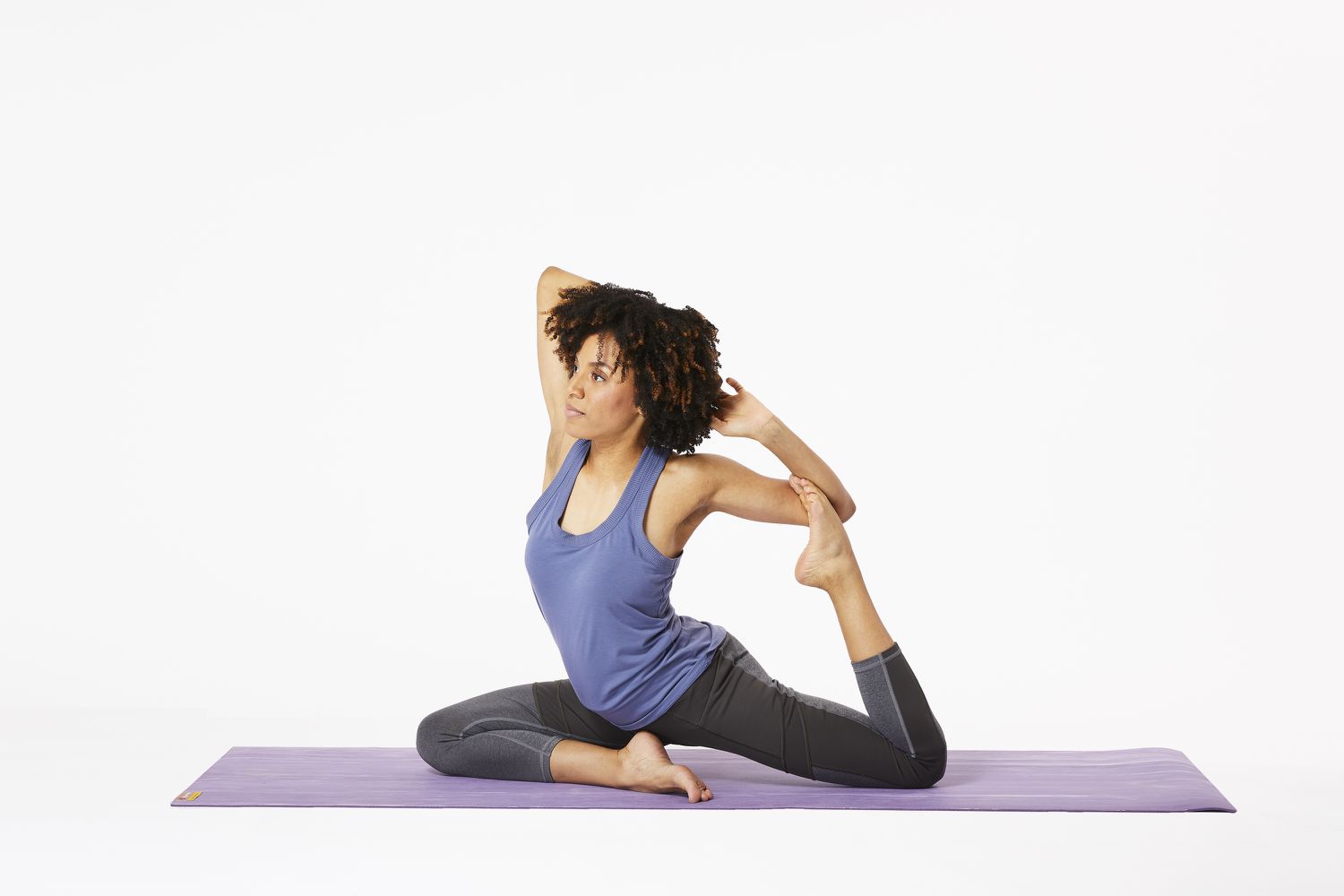
Beyond Physical Relief: A Portal to Emotional Healing
Eka Pada Rajakapotasana transcends its physical benefits, touching the realms of emotional healing and self-discovery. The act of surrendering into the pose, coupled with mindful breathing, encourages a release of deeply held fears and insecurities. This emotional catharsis can be particularly therapeutic during menstruation, a time when many feel more vulnerable and introspective. Engaging in Pigeon Pose invites a profound connection with one’s inner self, facilitating a journey of healing, acceptance, and self-love.
Practicing Eka Pada Rajakapotasana
To embrace the full potential of Pigeon Pose, approach the asana with patience and respect for your body’s limits:
1. **Start in a tabletop position**, then gently bring your right knee forward, placing it behind your right wrist while extending your left leg back.
2. **Square your hips** to the front of the mat, ensuring they remain level and grounded.
3. **Inhale to lengthen** your spine, and as you exhale, fold forward, resting your forehead on your hands or the mat for the forward fold variation.
4. **Hold the pose** for 1-3 minutes, focusing on deep, soothing breaths that encourage release and relaxation.
5. **To exit**, gently press back into a tabletop position and repeat on the other side.

Tailoring Eka Pada Rajakapotasana for Menstrual Health
Adapting Pigeon Pose for menstrual health involves honoring your body’s needs and making modifications as necessary. Placing a cushion or folded blanket under the hip of the bent leg can provide support and increase comfort. For those with severe discomfort, practicing a reclined variation of the pose can offer similar benefits without the intensity of the traditional posture.
10. Savasana (Corpse Pose): The Culmination of Relaxation and Renewal
In the realm of yoga, Savasana, or Corpse Pose, is often considered the most important and challenging asana, marking the culmination of a practice with a profound period of stillness and surrender. While it appears to be the simplest pose, lying flat on one’s back in total relaxation, its depth and significance resonate deeply within the yoga journey. Especially for individuals experiencing the discomforts of menstruation, Savasana serves as a sanctuary of peace, facilitating physical relaxation, emotional release, and holistic healing.
The Profound Simplicity of Savasana
Savasana transcends mere physical rest; it is an intentional practice of deep relaxation that touches the very core of one’s being. This pose invites a complete surrender of the body to the earth, allowing every muscle and fiber to relax while the mind floats in a state of conscious awareness. By embodying the symbolic death of old habits and tensions, Savasana paves the way for rebirth and renewal, offering a blank slate for the body and mind at the end of each practice.
A Balm for Menstrual Discomfort
For those navigating the ebbs and flows of menstruation, Savasana can be particularly therapeutic. It offers a reprieve from the physical discomfort and emotional turbulence often associated with the menstrual cycle. In this state of deep relaxation, the body can better regulate its systems, including the hormonal fluctuations that contribute to menstrual cramps and mood swings. The stillness of Corpse Pose also provides an opportunity for the body to absorb the benefits of the preceding asanas more deeply, enhancing overall well-being.
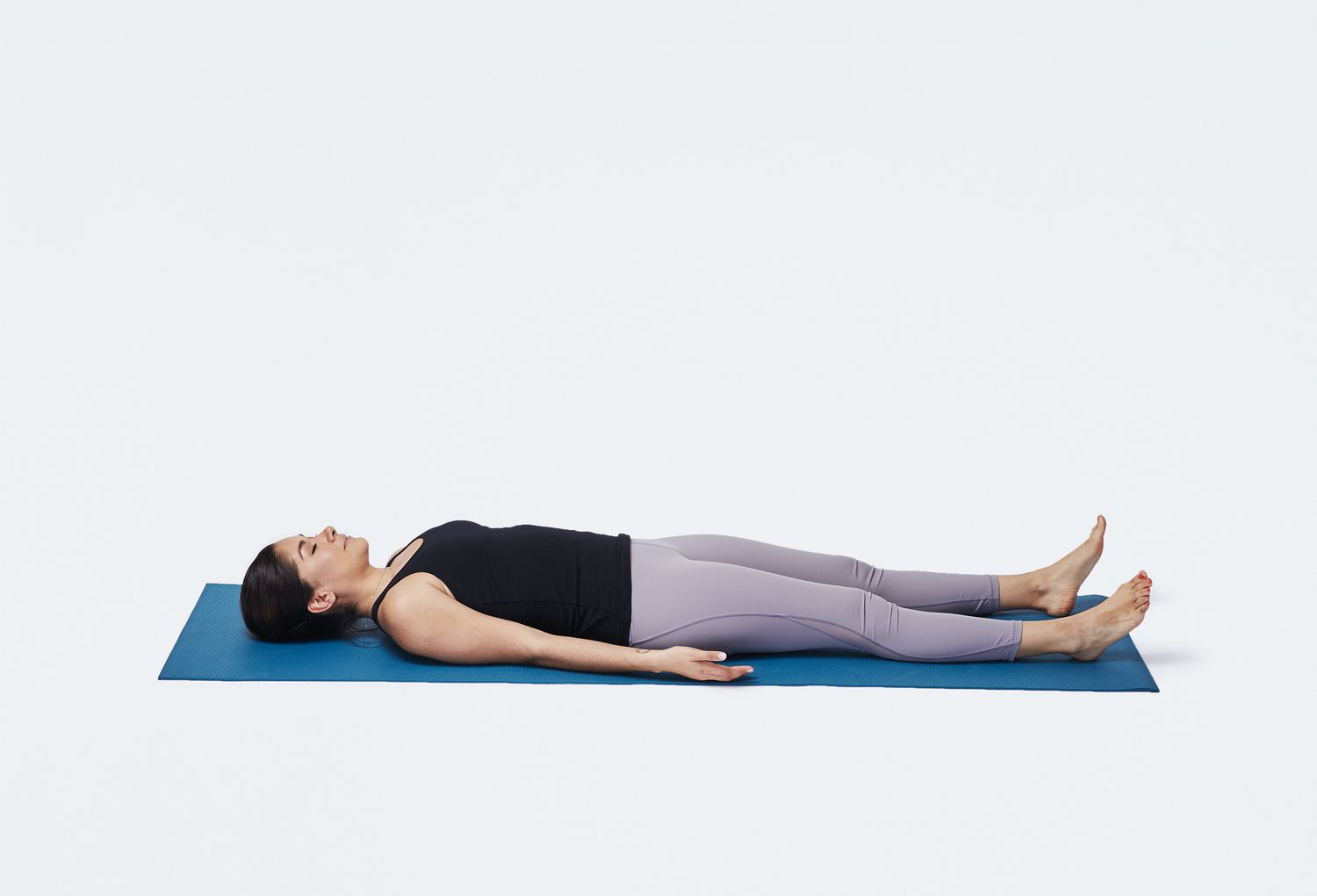
Beyond Relaxation: A Portal to Inner Peace
The true power of Savasana lies in its capacity to quiet the mind and foster a state of profound inner peace. In the stillness of Corpse Pose, practitioners are encouraged to observe their thoughts without attachment, allowing them to pass like clouds in the sky.
This practice of detachment and mindfulness can be incredibly liberating, especially during menstruation, when emotions can be more intense. Savasana offers a space to practice self-compassion and acceptance, embracing the body’s natural rhythms with grace.
Practicing Savasana
To fully embrace the benefits of Savasana, a few simple steps can guide you into a deeper relaxation:
1. **Lie flat on your back**, allowing your legs to splay open slightly and your arms to rest by your sides, palms facing upward.
2. **Close your eyes** and take a few deep breaths, consciously releasing tension with each exhale.
3. **Allow your breath to become natural**, focusing on the rise and fall of your abdomen, and invite your body to release into the earth with every exhale.
4. **Stay in Savasana** for 5-10 minutes, permitting yourself to drift into a state of deep relaxation and peace.
5. **To exit**, gently wiggle your fingers and toes, roll to one side in the fetal position, and slowly press yourself up to a seated position.

Tailoring Savasana for Menstrual Health
For those practicing Savasana during menstruation, incorporating props such as a bolster under the knees or a small pillow under the head can enhance comfort and support the lower back. Embracing the pose’s restorative nature can help ease menstrual discomfort and provide a moment of peaceful reflection.
In conclusion,
the exploration into yoga as a therapeutic practice for menstrual cramps reveals far more than a series of physical exercises; it uncovers a holistic pathway to wellness that intertwines the physical, emotional, and spiritual dimensions of health. Through the detailed examination of specific yoga poses designed to alleviate menstrual discomfort, we’ve seen how this ancient practice offers not just temporary relief but a profound, enduring transformation in how individuals experience their menstrual cycle.
Yoga, with its emphasis on mindfulness, breathwork, and intentional movement, stands as a powerful tool in the management of menstrual cramps, offering a natural, accessible form of relief that can be personalized to suit individual needs and preferences. Beyond its physical benefits, yoga fosters emotional well-being, helping to mitigate the stress and emotional turbulence often associated with menstruation. It encourages a deeper connection with oneself, promoting an attitude of self-care, compassion, and understanding.
Moreover, the practice of yoga for menstrual health extends its benefits into the realm of community and shared experience, creating spaces where individuals can connect, share, and support one another. This sense of community is invaluable, as it breaks down isolation and fosters a collective understanding and acceptance of menstruation as a natural, integral part of life.
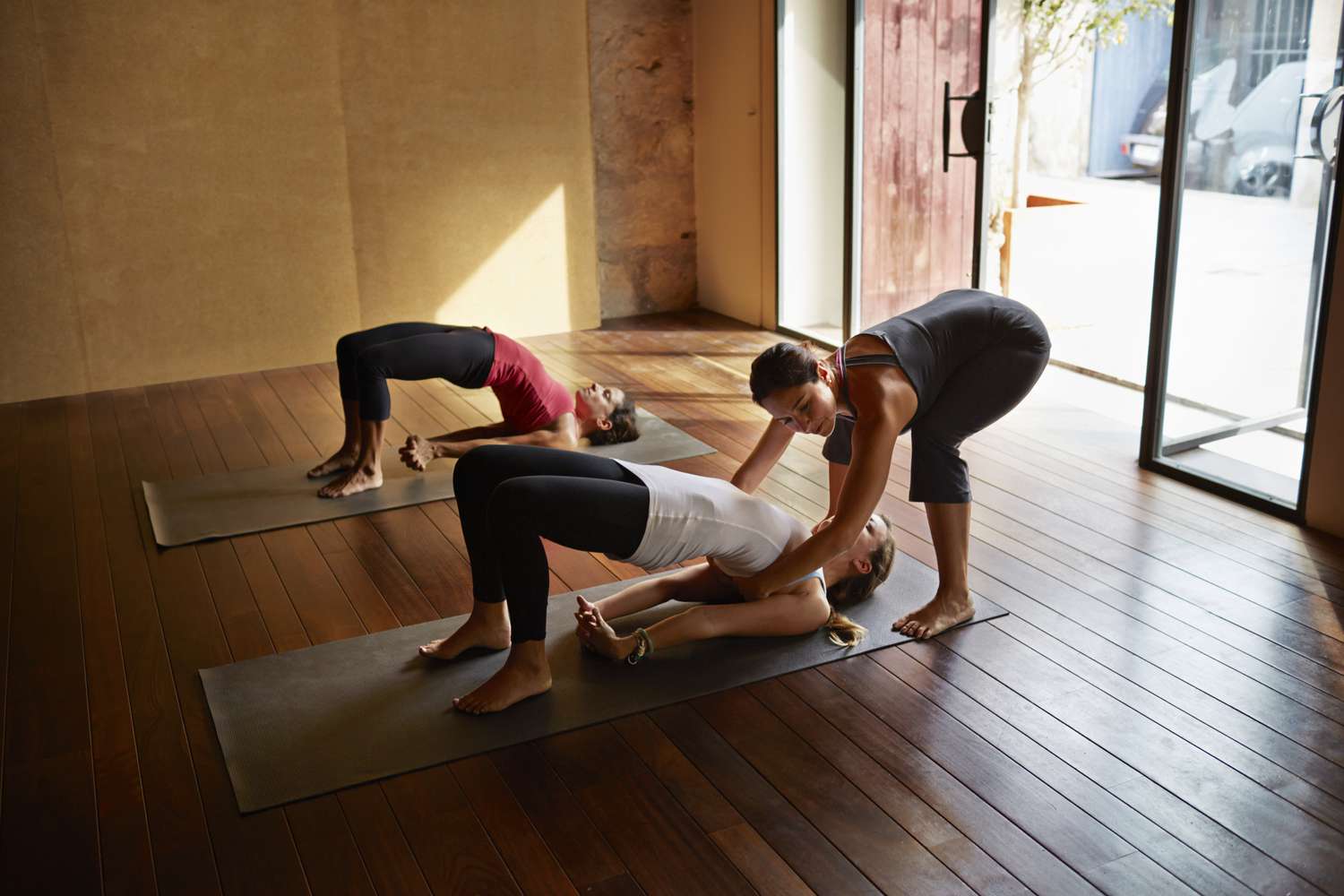
The journey through the top yoga poses for menstrual cramps is not just about combating physical discomfort; it’s about embracing a holistic approach to health that honors the body’s natural rhythms and cycles. It’s about empowering individuals to take control of their well-being, using the tools and teachings of yoga to navigate the challenges of menstruation with grace, strength, and resilience.
As we conclude this comprehensive exploration, let us reflect on the empowering message at the heart of using yoga for menstrual health: that through the integration of body, mind, and spirit, there exists a profound capacity for healing, growth, and transformation. Yoga offers not just a series of poses but a way of life—a path to discovering balance, peace, and well-being in all aspects of our lives, including our menstrual health.


